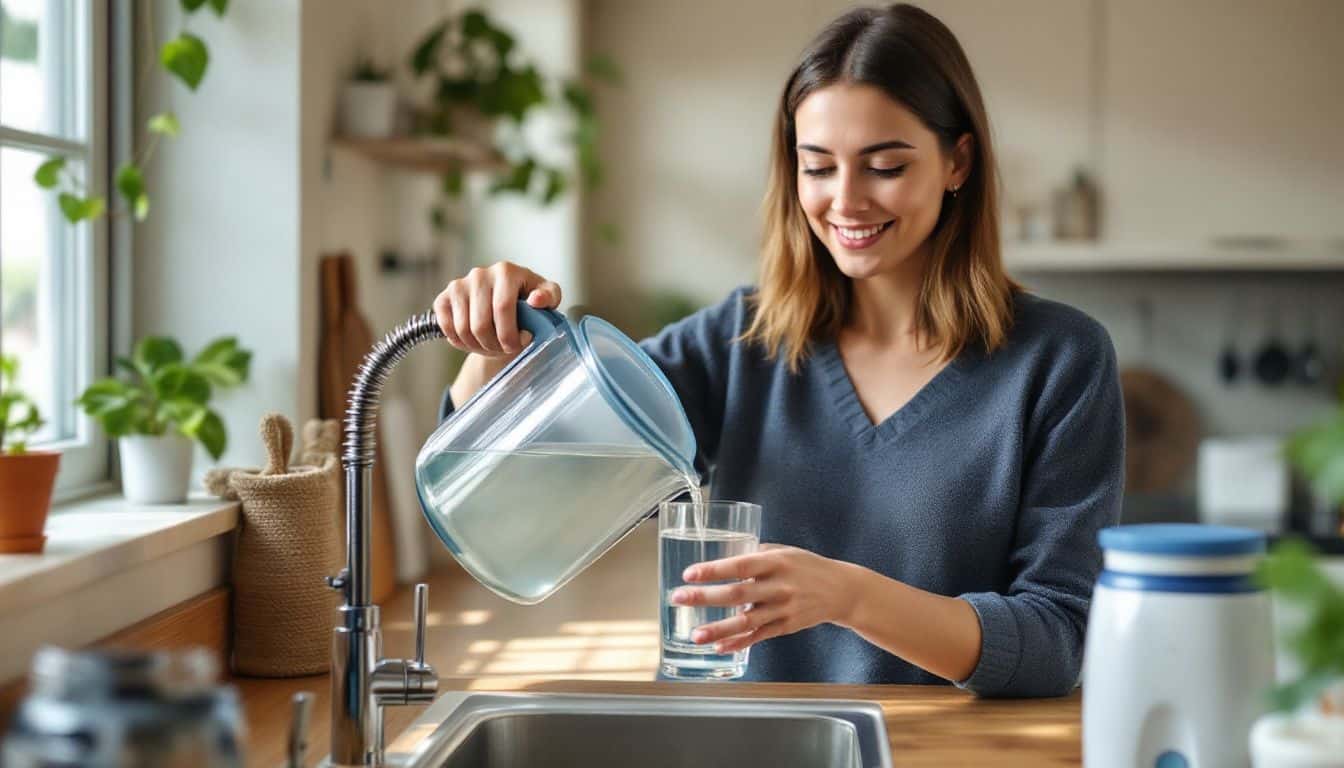Ever worry about the safety of your tap water? You’re not alone. Millions of Americans face water quality issues daily. 3 But don’t sweat it – making safe drinking water at home is easier than you think.
This guide will show you how to make safe drinking water at home with 5 crystal-clear tips. 2 Ready to quench your thirst… safely? 1
Key Takeaways
Boiling water for at least 1 minute kills most harmful microorganisms, making it a simple and effective way to purify water at home.
Adding 2–8 drops of unscented chlorine bleach per quart or gallon of water can disinfect it in about 30 minutes, costing only about 66 cents per person per year.
Common water contaminants include microorganisms, heavy metals like lead and arsenic, PFAS chemicals, pesticides, and nitrates/nitrites from fertilizers.
Popular home water treatment systems include reverse osmosis, activated carbon filters, UV purification, and ion exchange, each with pros and cons in terms of contaminant removal and maintenance needs.
Regular maintenance and filter/part replacements are crucial for water treatment systems to function properly, with costs and complexity varying by system type.
Table of Contents
Sources of Safe Drinking Water in Your Home
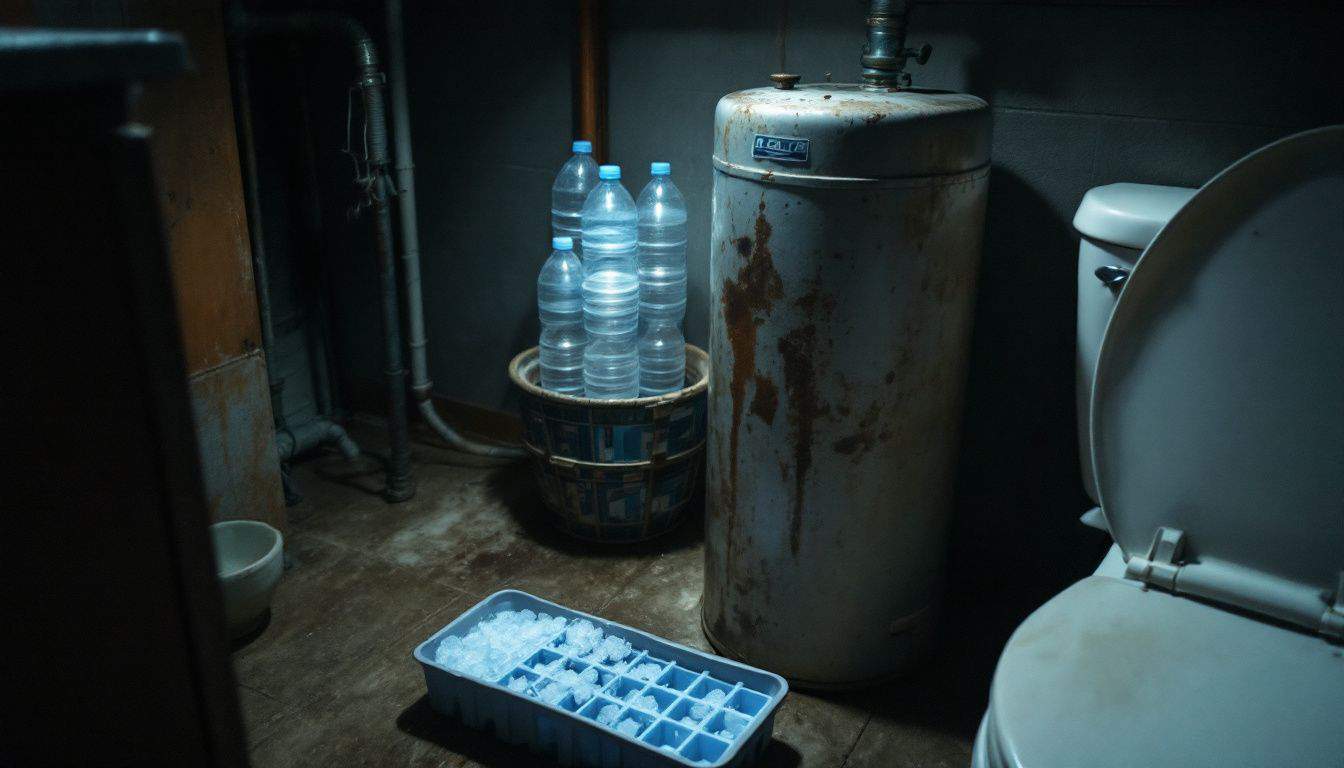
Hey guys, let’s chat about safe water at home. Your tap might not be reliable after a disaster hits. 1 But no worries! You’ve got options close by. That water heater in your basement? It’s a treasure trove.
Just cut the power, open the drain valve, and voila – gallons of clean H2O. Got ice cubes? Melt ’em. They’re like mini water reserves ready to use. 2
Here’s a tip from my camping experience: your toilet tank is a hidden supply. I know, it sounds weird. But if it’s free of cleaners, that water’s fine to use. Just avoid the bowl water – that’s off-limits.
Keep in mind, if your water smells like gas or looks strange, don’t drink it. Even boiling can’t fix that problem. Use bottled water if you’re not sure. It’s safer to be cautious about your health.
Effective Techniques for Purifying Water

Let’s dive into some easy ways to make your water safe to drink. These tricks will turn murky water into crystal-clear goodness – and they’re so simple, you’ll wonder why you didn’t try them sooner!
Boil Water for Safety
 Boiling water is a simple yet powerful way to make it safe to drink. It’s like giving your H2O a superhero cape! Just toss your water in a pot and crank up the heat. Let it bubble and dance for at least a minute – or three if you’re up in the mountains.
Boiling water is a simple yet powerful way to make it safe to drink. It’s like giving your H2O a superhero cape! Just toss your water in a pot and crank up the heat. Let it bubble and dance for at least a minute – or three if you’re up in the mountains.
This zaps most of those nasty bugs that can make you sick. 4 I once forgot about my boiling water and came back to a steamy kitchen… oops! But hey, better safe than sorry.
Here’s the cool part – you can store this super-safe water for later. Just pop it in a clean container with a lid. But heads up, fellas – boiling won’t kick out heavy metals or chemicals. 3 It’s not a cure-all, but it’s a solid start to safer sips. Trust me, your gut will thank you for taking this extra step. It’s way better than spending your weekend hugging the toilet!
Using Chemicals to Disinfect Water
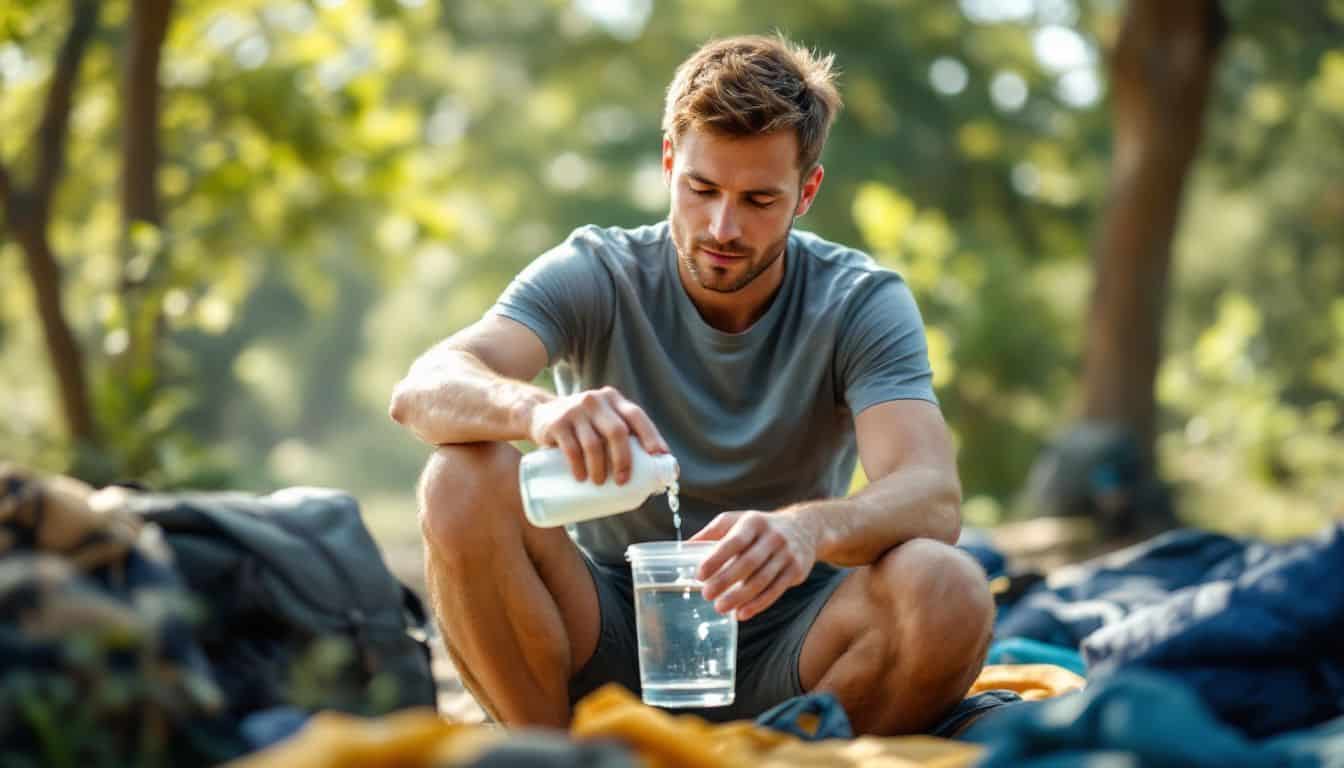
Chemicals can be a quick fix for clean water. Got some bleach? You’re in luck! Regular, unscented chlorine bleach is cheap and works great. Just add a few drops to your water – 2 drops per quart if it’s 6% or 8.25% strength.
For a gallon, use 8 drops of 6% or 6 drops of 8.25% bleach. Simple, right? Let it sit for half an hour, and you’re all set. You’ll know it’s safe when you smell a hint of chlorine.
Clean water is like liquid gold – and with the right chemicals, you can make it yourself!
I’ve used this method while camping, and it’s a real help. The taste isn’t great, but it’s better than getting sick. Plus, it’s super cheap – only about 66 cents per person per year. 5 Just keep in mind: no scented bleach, and don’t use too much. Too much chlorine can make you sick too. 3 Follow the dosage, and you’ll have safe, drinkable water quickly.
Filtering Impurities from Water
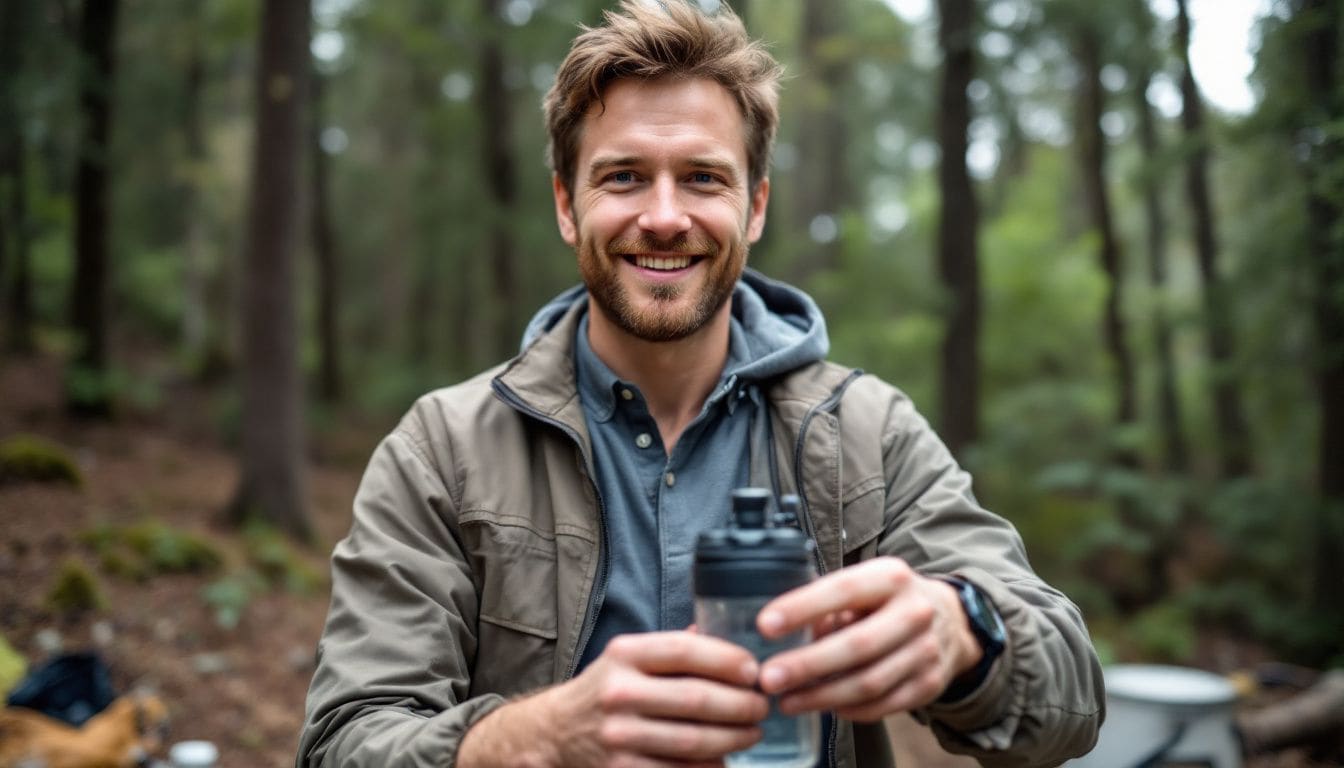
Filtering out nasties from your water is easier than you think. Got some clean cloths or coffee filters lying around? They’re perfect for catching larger particles. But don’t stop there – add a disinfectant after filtering to zap any sneaky germs.
For a more thorough clean, carbon filters are your best bet. These bad boys can trap almost all impurities, leaving you with crisp, clean H2O. 6
Looking for something a bit more high-tech? Ceramic and charcoal filters can catch tiny particles down to 0.2 microns. That’s smaller than most bacteria! If you’re feeling fancy, UV lamp purifiers are another solid option.
They’ll set you back about $80, but they’re great at killing microbes. Just swap out the lamp now and then. Up next, let’s explore water contaminants – it’s not as scary as it sounds!
Understanding and Addressing Common Water Contaminants
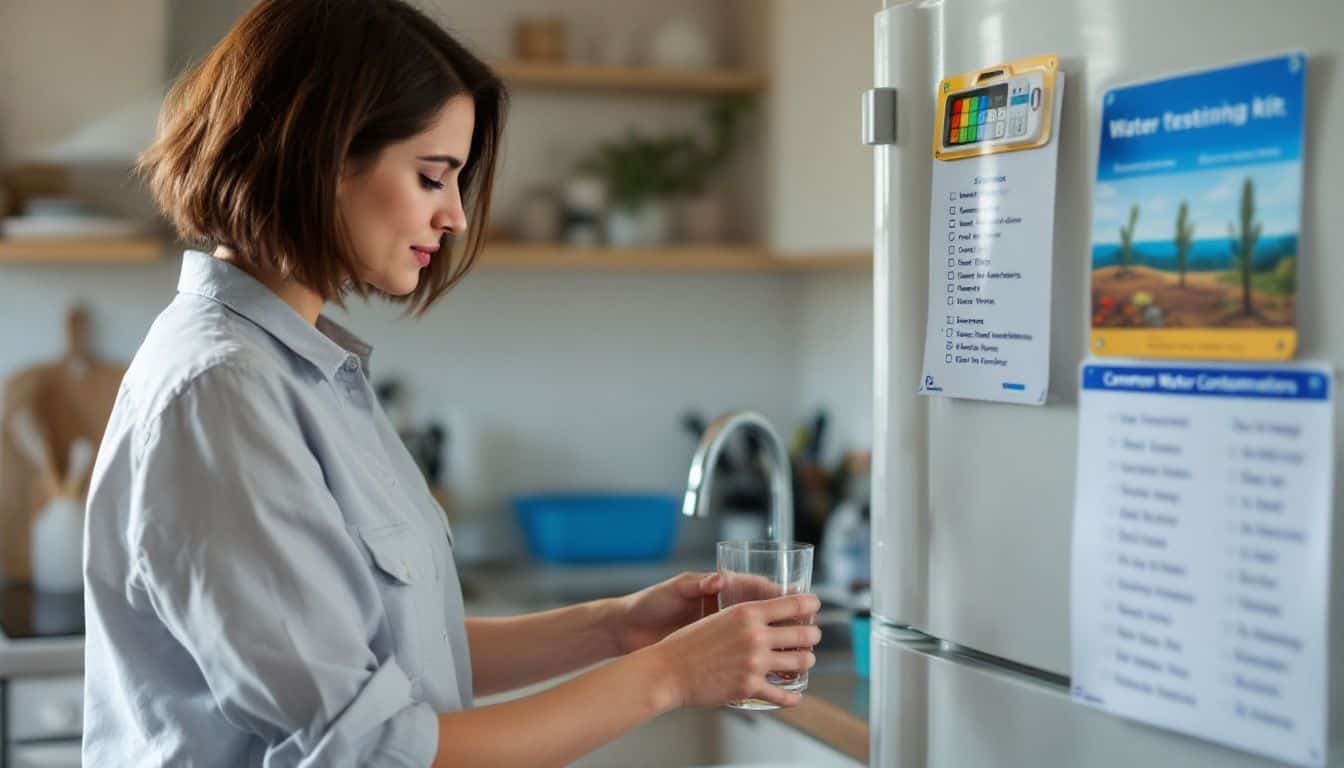
Water can hide some nasty surprises. Bugs, metals, and chemicals might be lurking in your glass. But don’t worry – we’ve got the scoop on what to watch out for… and how to kick those uninvited guests out of your H2O.
Keep reading to learn how to make your water crystal clear and safe to sip!
Microorganisms (bacteria, viruses, parasites)
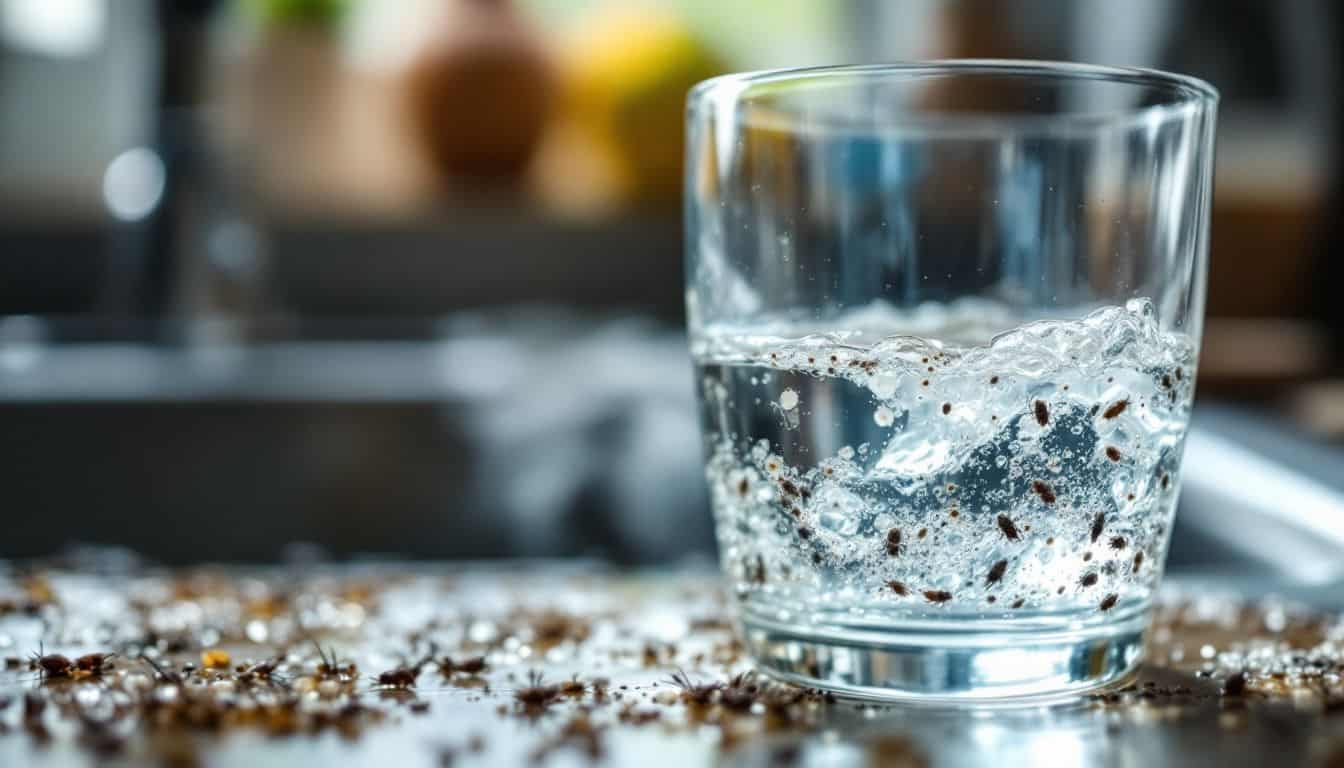
Tiny bugs in your water can make you sick. These bugs are so small you can’t see them. But they pack a punch! Bacteria, viruses, and parasites love to party in dirty water. They cause nasty illnesses like Giardia and rotavirus.
Yuck! These little troublemakers can give you the runs or worse. 7
Don’t worry, though. You can kick these germs to the curb. Boiling water for a minute zaps most of them dead. Can’t boil? No sweat. Filters with super tiny holes (less than 1 micron) can trap these party crashers.
It’s like having a bouncer for your water. 2 Next up, we’ll look at some other unwanted guests in your H2O – heavy metals.
Heavy metals (lead, mercury, arsenic)

Heavy metals in your water can be a real pain. Lead, mercury, and arsenic are the big three to watch out for. 8 These nasty guys can sneak into your pipes and cause some serious health issues.
Lead’s the worst for kids – it can mess with their growth and learning. Arsenic isn’t any better. It can make you sick if you drink it for a long time.
Clean water is a basic human right, not a luxury.
But don’t panic! There are ways to kick these metals out of your H2O. Water filters can help, but make sure you get one that’s made for heavy metals. Reverse osmosis systems are great at this job.
They can strip out those tiny metal bits like a champ. If you’re worried, get your water tested. It’s better to know what you’re dealing with than to guess.
PFAS (Per- and polyfluoroalkyl substances)
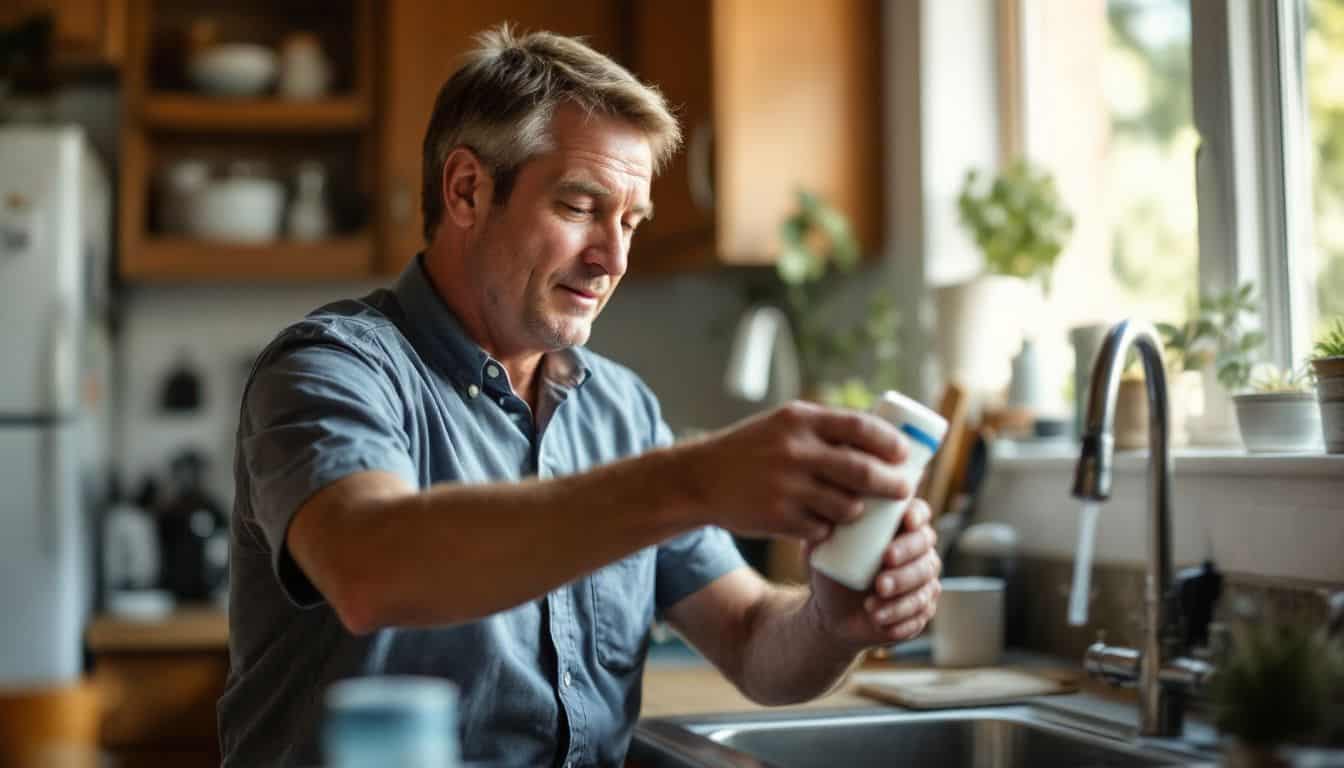
PFAS are sneaky little chemicals that have been causing a stir lately. These man-made substances are everywhere – in our water, air, and even our food. 9 They’re like unwanted house guests that just won’t leave.
Scientists have found PFAS in the blood of humans and animals, which is pretty scary stuff. 9 The EPA is keeping a close eye on these troublemakers because they stick around in the environment for a long time.
But don’t panic just yet, fellas. Experts are working hard to figure out how to kick PFAS out of our drinking water. They’re developing new ways to spot these chemicals and remove them from our H2O.
If you’re concerned about PFAS contamination in your water, it’s essential to not only address the issue with the right water treatment system but also understand the legal rights of PFAS victims. Knowing your rights can help you seek compensation or take necessary action. Now, let’s explore how to choose the best water treatment system for your home.
Pesticides and herbicides
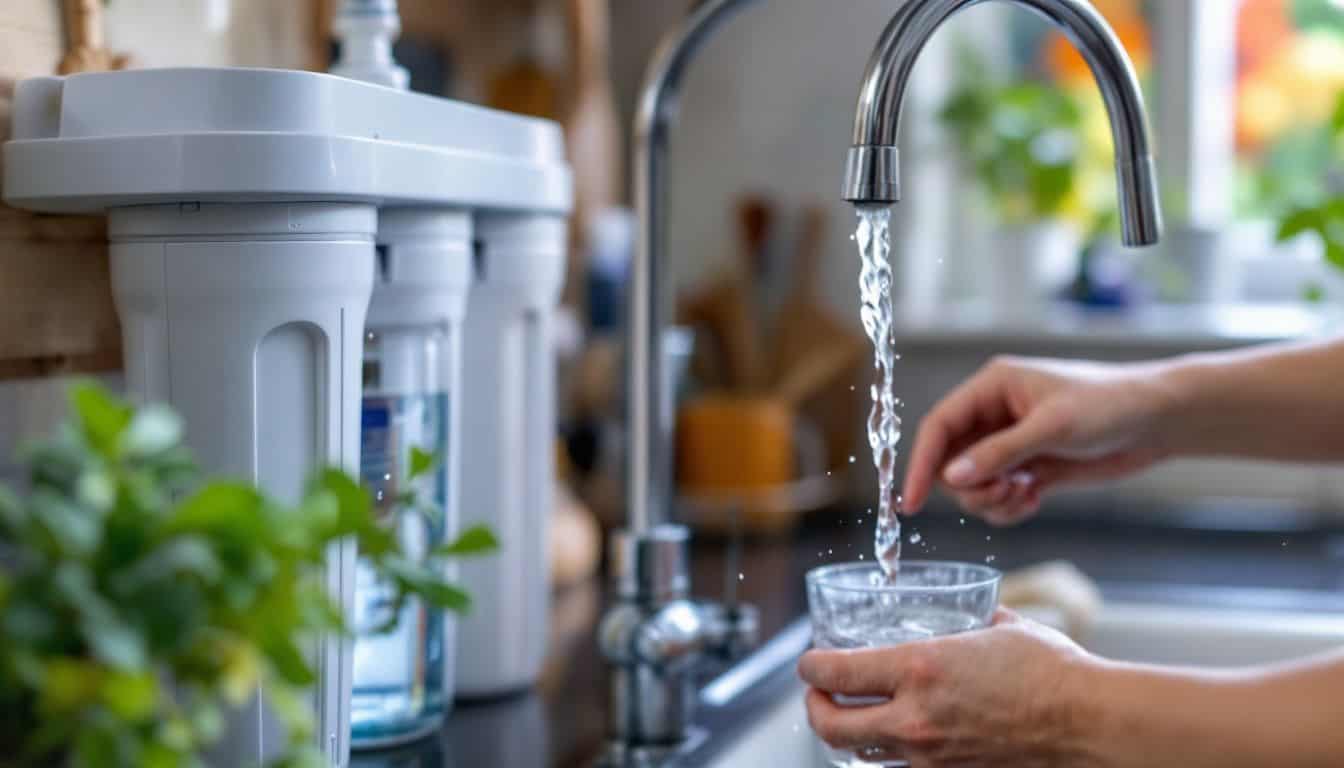
Pesticides and herbicides can sneak into your water supply. These chemicals often come from farms and gardens nearby. 11 They wash off crops and lawns when it rains. Then, they seep into groundwater or flow into rivers and lakes.
Drinking water with these toxins isn’t good for you. It can lead to serious health problems over time, even cancer. 10
You can’t see or taste most pesticides in water. But there are ways to keep them out of your glass. Home water filters can help. Look for ones that remove chemicals. Some folks also use special treatment systems.
These can clean a whole house’s water supply. It’s smart to get your water tested now and then. This way, you’ll know if you need to take extra steps to make it safe.
Nitrates and nitrites
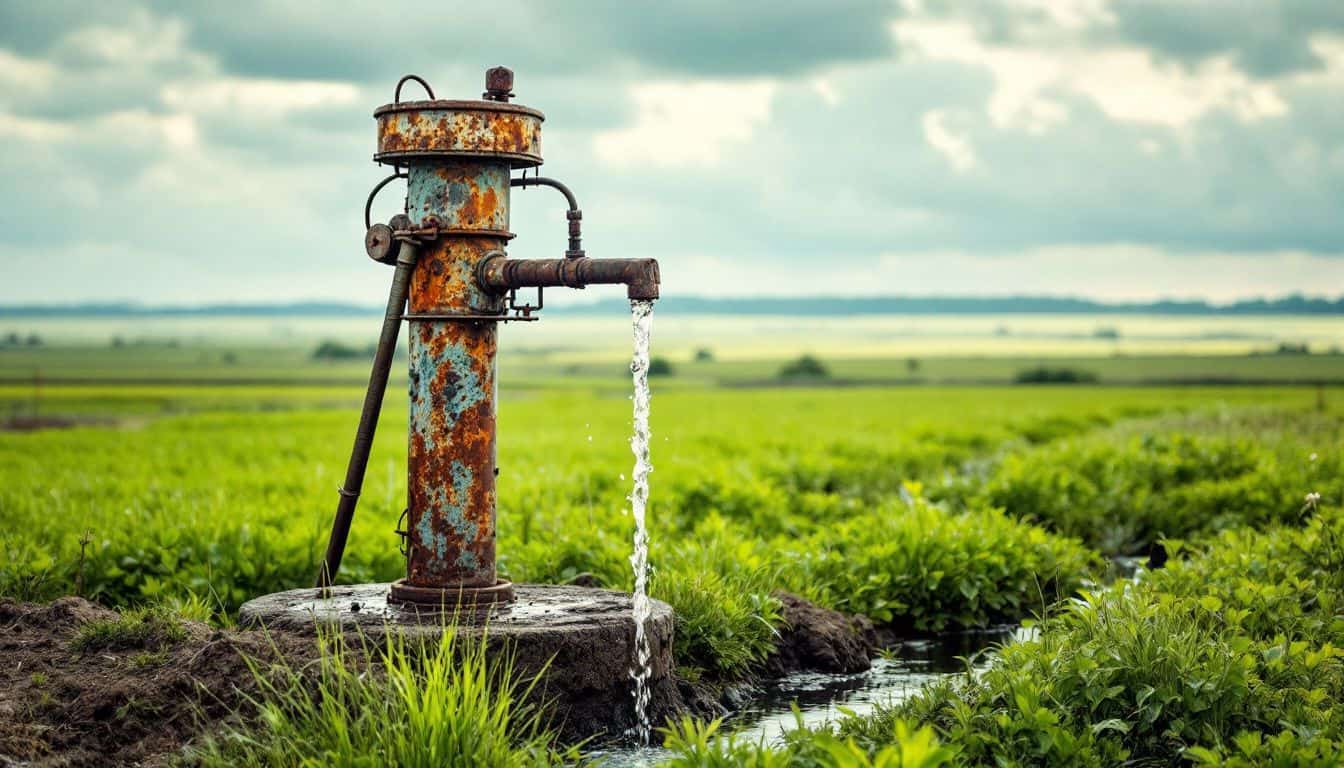
Nitrates and nitrites in your water can be bad news. These chemicals often come from farms using lots of fertilizer. 12 They seep into the ground and end up in our taps. For most adults, small amounts aren’t a big deal.
But for babies? It’s a different story. Their tiny bodies can’t handle these chemicals well. It can lead to a serious condition called “blue baby syndrome.” 12
The government keeps an eye on this stuff. They set rules for how much nitrate is okay in our water. But here’s the kicker – some places still have too much. I once tested my well water and got a shock.
The nitrate levels were through the roof! Had to get a special filter to fix it. So, it pays to be careful and check your water, especially if you’ve got little ones at home.
Clean water is not an expense, but an investment in our health and our children’s future.
Choosing the Right Water Treatment System for Your Home
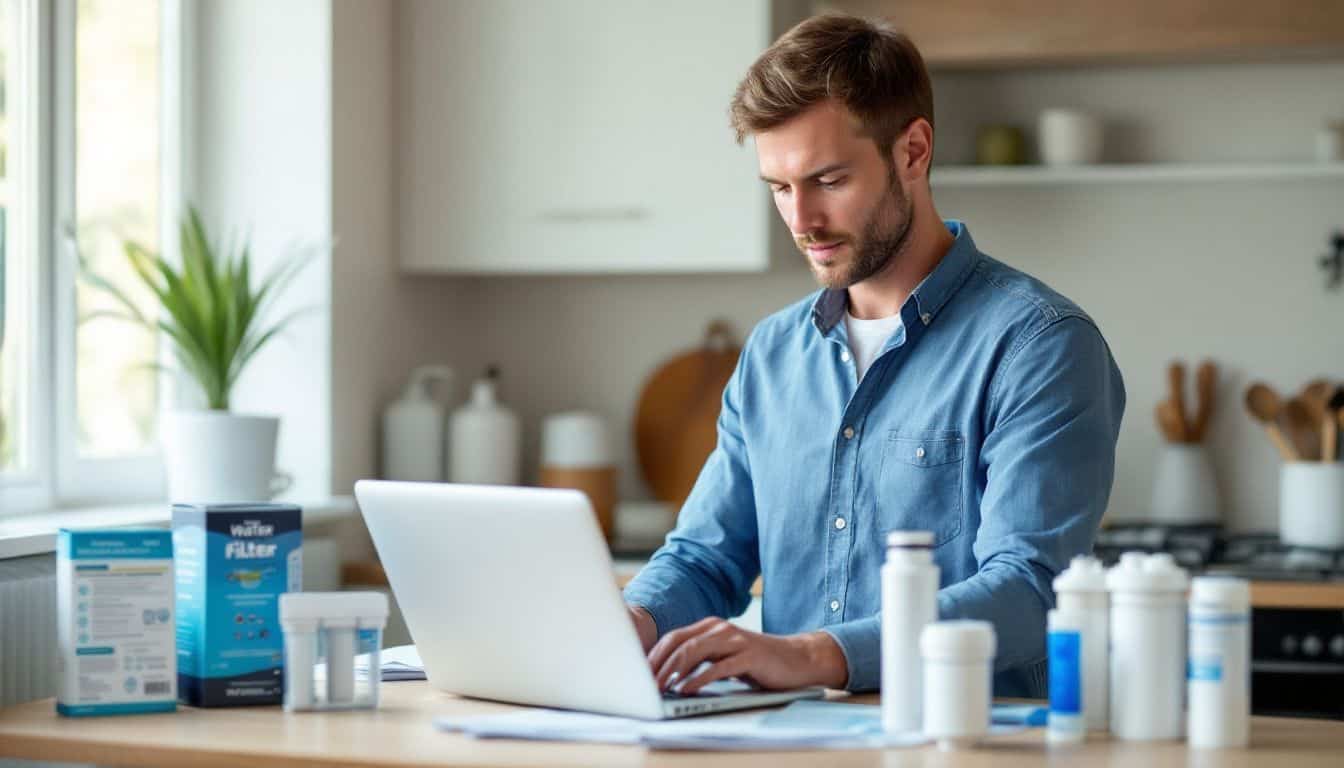
Picking the right water treatment system can be tricky. There’s a lot to think about – from what’s in your water to how much space you have. But don’t worry! We’ve got the lowdown on all the options… and trust me, you’ll want to stick around for this one.
Evaluating your water quality
Testing your water is key to knowing what’s in it. You can grab a home test kit from the store or call in the pros. These tests check for stuff like lead, bacteria, and other nasties. 13 They’ll give you the lowdown on what’s floating around in your H2O. Once you’ve got the results, you’ll know if your tap water is good to go or needs some TLC.
If your test shows problems, don’t freak out! There are plenty of ways to clean up your water. You might need a filter, a UV light, or even a whole-house system. The right fix depends on what’s in your water. 14 So, get that test done and take charge of your drinking water. Your body will thank you for it!
Types of water treatment systems (reverse osmosis, activated carbon, UV purification)
Water treatment systems can make your tap water safer and tastier. Let’s dive into some popular options that’ll have you sipping worry-free.
- Reverse Osmosis (RO): This powerhouse system forces water through a super-fine membrane. It kicks out up to 99% of contaminants, including fluoride, arsenic, and nitrates. RO is like a bouncer for your water, only letting the good stuff through. 15
- Activated Carbon: These filters are champs at soaking up chlorine, farm chemicals, and dirt. They work like a sponge, trapping the bad guys as water flows through. Your water comes out crisp and clean, perfect for that morning coffee. 15
- UV Purification: This method uses ultraviolet light to zap germs. It’s like sending your water to a tanning bed, but instead of a tan, it gets a clean bill of health. UV light messes with the DNA of nasty microorganisms, rendering them harmless.
- Ion Exchange: This system swaps out hard minerals for softer ones. It’s like a trade deal for your water – out with the calcium and magnesium, in with the sodium. Your pipes and appliances will thank you.
- Mechanical Filtration: Think of this as a colander for your water. It strains out solid particles, leaving you with clearer H2O. It’s simple but effective, especially for well water with sediment issues.
Now that we’ve covered the main players, let’s look at how to pick the right system for your home.
Pros and cons of different systems
Let’s break down the good and bad of different water treatment systems. Each has its strengths and weaknesses, so it’s crucial to know what you’re getting into. 16
| System | Pros | Cons |
|---|---|---|
| Reverse Osmosis | – Removes many contaminants – Effective against lead and copper – Low maintenance | – Wastes water – Removes beneficial minerals – Higher initial cost |
| Activated Carbon | – Improves taste and odor – Removes chlorine – Affordable | – Needs frequent filter changes – Less effective against microbes – Limited heavy metal removal |
| UV Purification | – Kills bacteria and viruses – No chemicals added – Low operating cost | – Doesn’t remove particles or chemicals – Requires clear water to work – Needs lamp replacement |
| Ion Exchange | – Softens hard water – Removes some heavy metals – Low energy consumption | – Increases sodium content – Requires salt for regeneration – Less effective against organic contaminants |
For those who want a portable option, the Travel Berkey water filter is worth checking out. It’s a hit among outdoor enthusiasts and preppers alike. Now, let’s move on to picking the right system for your home…
Maintenance and replacement considerations
Keeping your water treatment system in top shape isn’t rocket science, guys. But it does need some care. Most systems have filters or parts that need swapping out every few months or years.
It’s like changing the oil in your car – skip it, and you’re asking for trouble. The cost of these replacements can add up, so factor that into your budget when choosing a system. 17
Don’t forget about the warranty! It’s your safety net if something goes wrong. Some systems might need a pro to install or maintain them – that’s extra cash you’ll need to shell out.
But hey, it’s worth it for clean, safe water… right? Just keep in mind, a little upkeep now can save you big bucks (and headaches) later on. 18
People Also Ask
What’s the quickest way to make water safe to drink at home?
Boiling is your best bet. Just bring water to a rolling boil for a minute. It’s like magic – the heat zaps those nasty bugs! For cloudy water, let it settle and filter the clear stuff off the top.
Can I use bleach to make my water drinkable?
You bet! A dash of household bleach can work wonders. Add about 8 drops per gallon of clear water. Stir and wait 30 minutes. Presto! You’ve got potable water. Just make sure it’s unscented bleach with sodium hypochlorite as the only active ingredient.
Are water purification tablets a good option for clean H2O?
Absolutely! These little lifesavers are great for emergencies. Chlorine dioxide tablets are top-notch for killing waterborne nasties. They even tackle tough customers like cryptosporidium. Follow the instructions on the package for crystal-clear results.
How effective are water filtration systems for home use?
They’re a solid choice! A good filtration system can remove many contaminants. It’s like having a mini water treatment plant in your kitchen. Look for one that tackles both chemical and biological baddies. Remember, though, no filter is perfect.
Is iodine a reliable method for water disinfection?
It can be, in a pinch. Iodine tablets or solutions can knock out many waterborne diseases. But heads up – it’s not great for long-term use. Some folks don’t dig the taste, and it’s not safe for pregnant women or those with thyroid issues.
What’s the deal with distilled water? Is it safer than other types?
Distilled water is the clean freak of the water world. The distillation process boils water and collects the steam, leaving impurities behind. It’s super pure, but it might lack some beneficial minerals. It’s great for certain uses, but for everyday drinking, other methods work just fine.
References
^ https://www.cdc.gov/water-emergency/about/index.html (2024-09-19)
^ https://www.fema.gov/press-release/20210318/fact-sheet-how-make-your-water-safe-drink (2021-03-18)
^ https://www.epa.gov/ground-water-and-drinking-water/emergency-disinfection-drinking-water (2024-06-24)
^ https://www.wikihow.com/Boil-Drinking-Water
^ https://www.ncbi.nlm.nih.gov/pmc/articles/PMC8201346/
^ https://www.filtsep.com/content/blog/effective-and-proven-ways-to-purify-your-water-at-home/ (2022-06-10)
^ https://www.health.state.mn.us/communities/environment/water/contaminants/bacteria.html
^ https://www.ncbi.nlm.nih.gov/pmc/articles/PMC4144270/
^ https://www.epa.gov/pfas/pfas-explained
^ https://www.ncbi.nlm.nih.gov/pmc/articles/PMC9428564/
^ https://www.ncbi.nlm.nih.gov/pmc/articles/PMC7826868/
^ https://www.healthvermont.gov/environment/drinking-water/nitrates-and-nitrites-drinking-water
^ https://smartwatertt.com/how-to-choose-the-best-water-treatment-for-your-home/
^ https://www.tceq.texas.gov/drinkingwater/choosing-home-water-treatment
^ https://www.aquasana.com/info/top-5-types-of-drinking-water-filtration-pd.html
^ https://modernize.com/plumbing/water-treatment
^ https://geteco.com/cincinnati-oh/blog/how-to-choose-the-right-water-treatment-system-for-your-home/
^ https://www.linkedin.com/pulse/water-filtration-tips-ensuring-clean-safe-ky3qc
